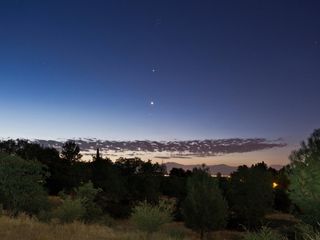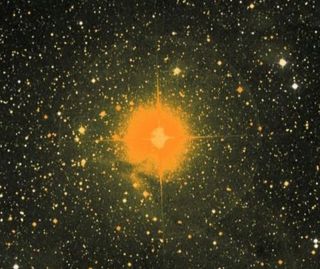Extreme Stargazing: The Biggest, Brightest and Best Night Sky Sights

This week we delve into some "extreme astronomy," for a number of skywatching superlatives are overhead now.
Our current morning sky contains the brightest planet and largest star, for example, while the evening sky boasts the most luminous star, the most colorful star and the most distant object that can be seen with the naked eye.
The Brightest Planet: This one, of course, is Venus, which rises a little north of east shortly before 3 a.m. daylight savings time. It will continue to dominate the morning sky into the beginning of winter.
September will be the peak of Venus’ highest morning apparition — or period of naked-eye visibility — for mid-northern skywatchers in its eight-year apparition cycle. Despite the fact that Venus was at greatest elongation (maximum angular separation) from the sun on Aug. 15, the planet is even a bit higher during the month of September — about 40 degrees off the horizon at each September sunrise around latitude 40 degrees north. [Bright Planets in Summer Night Sky Explained (Infographic)]

On Sept. 12, you’ll find the planet far below Castor and Pollux and about 5 degrees to the left of a narrow crescent moon. The very next morning, shining at magnitude -4.2, Venus will glide 3 degrees south of the center of M44, the Beehive star cluster in the constellation Cancer (The Crab).
This lovely event will be best seen in binoculars or a wide-field telescope. Telescopes will show Venus’ increasingly gibbous form slowly shrinking as it recedes from Earth this month. Sunrise or late in the morning twilight is usually the best time to study Venus in telescopes.
The Largest Star: The largest known star lies within the constellation of Canis Major, the Big Dog. Right now, Canis Major can be seen emerging from the southeastern horizon just as dawn is beginning to break. He is the larger of Orion’s two faithful dogs, who are getting ready to follow the Mighty Hunter across the sky for yet another impending winter season. Within Canis Major gleams Sirius, the Dog Star, which is the brightest star in the sky. But it's not the largest.
Sign up for the Live Science daily newsletter now
Get the world’s most fascinating discoveries delivered straight to your inbox.
That distinction goes to another star in the Big Dog, VY Canis Majoris, a hypergiant star located about 3,800 light-years from Earth. University of Minnesota professor Roberta Humphreys recently calculated that it may be more than 2,100 times the size of the sun.
Placed in our solar system, VY Canis Majoris' surface would extend out past the orbit of Saturn. Light would take more than 8.5 hours to travel around the star's circumference, compared to 14.5 seconds for the sun. If we could shrink the sun down to the size of a baseball, VY Canis Majoris would be a globe measuring 402 feet (122.5 meters) in diameter!
But using the word "globe" to describe this star is actually a bit misleading; a globe suggests a solid object, but there is nothing solid about VY Canis Majoris. In fact, the star is a thousand times less dense than Earth's atmosphere at sea level.
VY Canis Majoris is an M-type star, a cool red star with a temperature of about 5,840 degrees Fahrenheit (3,227 degrees Celsius). And it is enveloped by a huge nebula sporting a complex structure with filaments and arcs caused by past eruptions.
The star is the source of considerable controversy, since the estimates of its size and luminosity fall outside the bounds of current stellar theory. And as for its future, VY Canis Majoris is forecast to become a "hypernova" sometime within the next 100,000 years, producing a burst of energy that would be substantially higher than the typical supernova star explosions. [Gallery: Great Supernova Photos]
Hypernovas are believed to be the origin of long-duration gamma-ray bursts. VY Canis Majoris might even end up as a large black hole.
The Brightest Star: In 1997, UCLA astronomers using NASA's Hubble Space Telescope identified what may be the most luminous star known — a celestial mammoth 25,000 light-years away that releases up to 10 million times the energy of the sun and is big enough to fill the diameter of Earth's orbit.
Unfortunately, this amazing star is not visible to skywatchers here on Earth. It's located in the direction of the constellation Sagittarius, hidden behind the great dust clouds along the Milky Way.
Astronomer Don Figer suggested that this star also created a surrounding cloud of glowing gas, which has been dubbed the Pistol Nebula. As such, this powerhouse star is called the "Pistol Star." It unleashes as much energy in six seconds as our sun does in an entire year.
Look to the south-southwest sky after darkness has fallen to find Sagittarius, often depicted in allegorical star atlases as a centaur but who long ago was simply the standing Archer (looking with some apprehension toward the Scorpion immediately to his west).
About two-fifths of the way up from the star Al Nasl northwest to Theta Ophiuchi lies the direction of the center of our Milky Way system, appearing as a veritable cloud of stars. This is also the same region of the sky where the Pistol Star is located, but hidden from our view by that cloak of interstellar dust.
Interestingly, on average, there are less than half a dozen specks of this microscopic matter in each cubic mile of space, yet this total is still sufficient to present an impenetrable curtain between us and the most luminous of all stars.
Even the most powerful telescopes cannot see this star in visible wavelengths. However, 10 percent of the infrared light leaving the star does manage to reach Earth, putting it within reach of infrared telescopes, which have seen rapid technological advances in recent years.
The Pistol Star may be only 1 to 3 million years old, and it will probably live for only another 1 to 3 million years before finally dying in a supernova explosion.
The Most Colorful Star: In recent weeks, we’ve discussed stars with vivid colors. A case in point: the beautiful double star Albireo (blue and orange) and Antares (fiery red). But the title of the reddest star that's visible to the naked eye likely belongs to a star in the constellation of Cepheus, the King.
Rather than a king, this constellation seems to resemble a church with a steeple or perhaps an Alpine ski lodge with a steep, snow-shedding roof. This dim stellar outline is best seen on moonless transparent nights as Cepheus wheels high above the celestial pole at this time of year.

Located just below the foundation of the church or ski lodge is the star Mu Cephei, sometimes also known as Erakis, and christened by famed British astronomer William Herschel as "The Garnet Star." Here is a red giant that apparently is in the same class of stars as Betelgeuse in Orion.
It’s a pulsating variable star, categorized as having an irregular period. But it seemingly takes an average of 755 days to go from a star with a brightness of magnitude 3.7 down to about 5.0 before brightening back up again. (In astronomy, lower magnitudes signify brighter objects. The full moon has a magnitude of about -13.)
But it’s the color that makes Mu a standout. According to Richard Hinckley Allen in his classic work "Star Names: Their Lore and Meaning," Mu is one of the deepest-colored stars visible to the naked eye. But like its brightness, its color too can appear to vary.
Most of the time Mu appears a deep orange-red, but on occasion it has seemed to take on a weird purplish tint. It’s a pity that The Garnet Star is not just a bit brighter, but nonetheless, with careful scrutiny, its ruddy cast is apparent even to the unaided eye on a dark night, and it’s stunning in good binoculars.
The Most Distant Object Visible with the Unaided Eye: During the 10th Century, the Persian astronomer Al Sufi drew attention amidst the stars that we now call Andromeda, or the Princess, to a "Little Cloud."
Even today, binoculars and telescopes reveal that "cloud" as little more than an elongated fuzzy patch, which gradually brightens in the center to a star-like nucleus. Though this patch is faint, realize that, as you see it tonight, its light has been traveling some 2.5 million years to reach you, traveling all that time at 671 million mph (1.08 billion kph).
The light you are seeing is 25,000 centuries old and began its journey around the time of the dawn of human consciousness. When it began its nearly 15-quintillion-mile journey Earthward, mastodons and saber-toothed tigers roamed over much of pre-ice-age North America, and prehistoric man struggled for existence in what is now the Olduvai Gorge of East Africa.
Amazingly, this fuzzy "little cloud" is actually made up of more than 400 billion stars like the one in our sky, and we know it today as The Great Andromeda Galaxy. It is so distant that only a telescope and camera combined can show its true nature. Long exposure photographs reveal it to be a whole universe of stars like our own Milky Way galaxy. [Video: Milky Way and Andromeda on Crash Course]
The Milky Way, or Via Lactea in Latin, was named for its appearance in the night sky. Similarly, the word "galaxy" stems from the Greek "gala" and "kyklos," which mean milk and circle, respectively.
When we began to realize that there are other such vast collections of stars out there in the cosmos, we first called them "island universes," but this was an obvious misnomer. Since universe means everything there is,many people are uncomfortable making the word plural. So we’ve settled on "galaxies," which is a compromise as a new meaning for an old word.
Joe Rao serves as an instructor and guest lecturer at New York's Hayden Planetarium. He writes about astronomy for The New York Times and other publications, and he is also an on-camera meteorologist for News 12 Westchester, New York.












